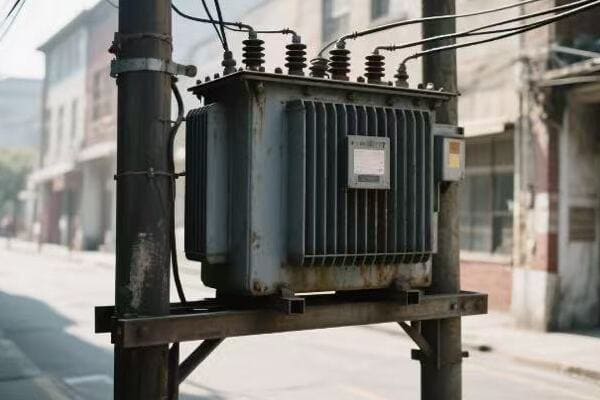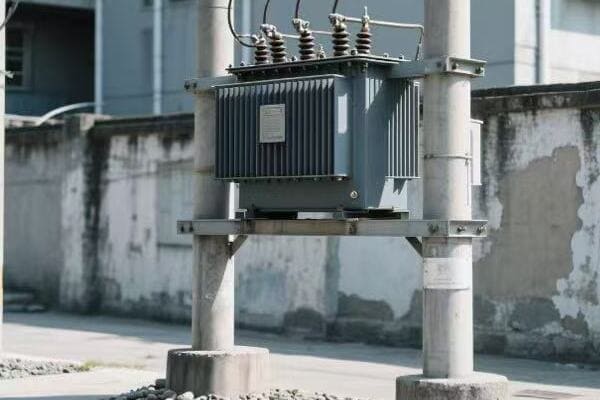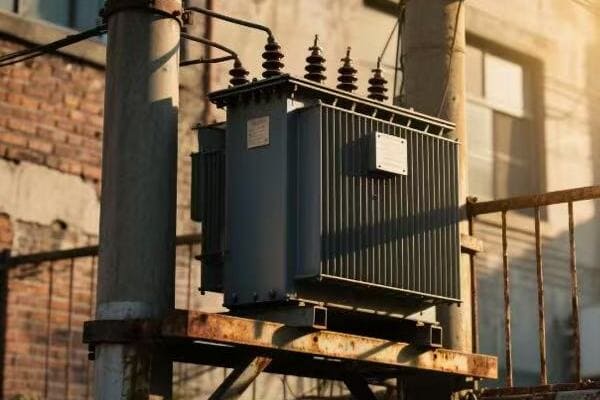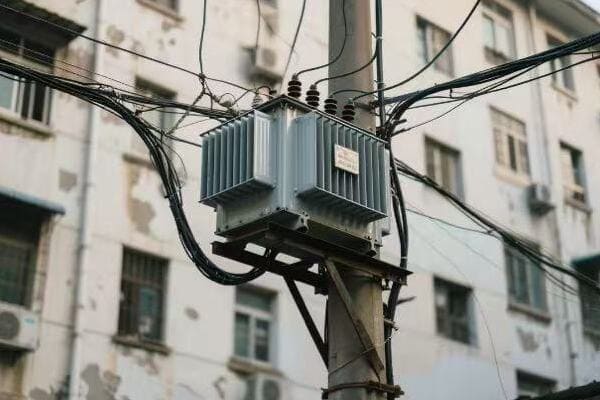Have you ever wondered how remote villages get electricity? The answer might be hanging right above your head. Single phase pole mounted transformers are changing the game in rural electrification.
Single phase pole mounted distribution transformers are revolutionizing rural electrification by providing reliable power to remote areas while incorporating smart grid features. These transformers combine traditional robustness with modern technology to bridge the energy gap in rural communities.

As someone who's worked in the power industry for years, I've seen firsthand how these transformers are making a difference. Let's explore how they're shaping the future of rural power distribution.
Powering Rural Progress: The Impact of Single Phase Pole Mounted Transformers?
Rural electrification is more than just bringing light to homes. It's about powering progress and opening up new opportunities for communities.
Single phase pole mounted transformers are significantly impacting rural progress by providing reliable and efficient power distribution. They enable the electrification of remote areas, supporting economic growth, education, and improved quality of life in rural communities.

Let's dive into the key impacts of these transformers on rural development:
Economic Empowerment
Electricity is a catalyst for economic growth:
- It enables small businesses to operate machinery and equipment
- Farmers can use electric pumps for irrigation
- Cottage industries can expand their production capabilities
Educational Advancement
Power brings new learning opportunities:
- Students can study after dark
- Schools can use computers and internet for better education
- Access to information through TV and radio becomes possible
Healthcare Improvements
Reliable electricity enhances medical care:
- Clinics can operate essential medical equipment
- Vaccines and medicines can be properly refrigerated
- Telemedicine becomes feasible in remote areas
Enhanced Quality of Life
Electricity transforms daily living:
- Homes can have lighting, fans, and basic appliances
- Communication improves with charged mobile phones
- Entertainment options increase, reducing rural-urban divide
Environmental Benefits
Proper electrification can be eco-friendly:
- Reduces reliance on kerosene lamps and diesel generators
- Enables the use of cleaner, electric-powered tools
- Supports the integration of renewable energy sources
| Impact Area | Before Electrification | After Electrification |
|---|---|---|
| Economic | Limited business hours | Extended operations |
| Education | Study limited to daylight | 24/7 learning opportunities |
| Healthcare | Basic services only | Advanced medical capabilities |
| Quality of Life | Manual, time-consuming tasks | Efficient, powered alternatives |
| Environment | High carbon footprint | Reduced emissions |
I remember a project where we installed these transformers in a remote mountain village. Before, the village relied on a few hours of diesel generator power each day. Within months of electrification, we saw new businesses springing up. A local carpenter told me he could now use electric tools, doubling his productivity. The village school started a computer class, opening up a world of digital learning to the students.
Another impactful experience was in a farming community that had struggled with irrigation. With the new transformer, they could run electric pumps. Crop yields increased significantly, and some farmers even started exporting their produce. The economic uplift was visible in new homes, better roads, and even a small clinic that could now operate X-ray machines.
These experiences showed me that single phase pole mounted transformers are more than just pieces of equipment. They're catalysts for change, bringing the power of electricity to transform lives and communities. The impact goes far beyond just lighting up homes; it's about lighting up futures and powering progress in rural areas that have long been left in the dark.
Smart Grid Ready: Integrating Advanced Features for Future-Proof Rural Networks?
The future of power distribution is smart, even in rural areas. Single phase pole mounted transformers are evolving to meet this challenge, integrating advanced features that make rural networks future-proof.
Smart grid ready single phase pole mounted transformers integrate advanced features like remote monitoring, automated voltage regulation, and data analytics capabilities. These features ensure that rural power networks are prepared for future technological advancements and changing energy needs.

Let's explore the key smart grid features being integrated into these transformers:
Remote Monitoring and Control
Keeping an eye on transformers from afar:
- Sensors collect real-time data on voltage, current, and temperature
- This data is transmitted to control centers via cellular or satellite networks
- Operators can remotely adjust transformer settings
Automated Voltage Regulation
Maintaining stable power quality:
- Transformers can automatically adjust voltage levels
- This compensates for fluctuations due to varying loads or line losses
- It ensures consistent power quality for rural consumers
Fault Detection and Self-Healing
Quick response to power disruptions:
- Transformers can detect and isolate faults
- Some can automatically reconfigure the network to restore power
- This reduces outage duration and improves reliability
Data Analytics for Predictive Maintenance
Preventing issues before they occur:
- AI algorithms analyze transformer performance data
- They predict potential failures or maintenance needs
- This allows for proactive maintenance, reducing downtime
Integration with Renewable Energy
Supporting green power in rural areas:
- Transformers can handle bi-directional power flow
- This allows for integration of solar or wind power
- It supports the growth of microgrids in rural communities
| Smart Feature | Benefit | Impact on Rural Network |
|---|---|---|
| Remote Monitoring | Quick issue detection | Reduced maintenance visits |
| Voltage Regulation | Stable power quality | Better appliance performance |
| Fault Detection | Faster outage response | Improved reliability |
| Predictive Maintenance | Reduced downtime | Lower operational costs |
| Renewable Integration | Green energy support | Sustainable rural power |
I recall a project where we upgraded a rural network with these smart transformers. The local utility was skeptical about the investment, but the results were eye-opening. Within the first month, the remote monitoring system detected a developing fault in one transformer. We fixed it before it could cause an outage, saving the community from a potential blackout that could have lasted days.
Another interesting case was in a farming region prone to voltage fluctuations due to irrigation pump usage. We installed transformers with automated voltage regulation. The farmers were amazed at how their equipment now ran more smoothly and efficiently. One farmer told me his pump motor, which used to burn out annually, was still running perfectly after two years.
These experiences showed me that making rural networks smart grid ready is not just about fancy technology. It's about bringing reliable, high-quality power to rural areas, reducing operational costs for utilities, and preparing these communities for future energy needs. As we continue to bridge the urban-rural divide in energy infrastructure, these smart transformers are proving to be invaluable tools in creating resilient and future-proof rural power networks.
Overcoming Rural Challenges: Innovative Solutions in Transformer Design?
Rural areas present unique challenges for power distribution. Single phase pole mounted transformer designers are rising to these challenges with innovative solutions that address the specific needs of rural environments.
Innovative designs in single phase pole mounted transformers are overcoming rural challenges through features like enhanced weather resistance, wildlife protection, and simplified maintenance. These solutions ensure reliable power distribution in remote and often harsh rural conditions.

Let's explore the key innovations addressing rural challenges:
Enhanced Weather Resistance
Battling the elements:
- Galvanized steel tanks resist corrosion in humid environments
- Special coatings protect against salt spray in coastal areas
- Reinforced designs withstand high winds in open landscapes
Wildlife Protection
Safeguarding against animal interference:
- Insulated bushings prevent animal-caused short circuits
- Expanded metal meshes keep birds from nesting in transformers
- Animal guards on poles deter climbing creatures
Simplified Maintenance
Making upkeep easier in remote locations:
- Modular designs allow for quick part replacements
- Self-cleaning radiators reduce the need for manual cleaning
- Extended oil life reduces the frequency of oil changes
Overload Capacity
Handling fluctuating rural power demands:
- Designs that can handle temporary overloads
- This is crucial during harvest seasons or community events
- It provides flexibility without needing oversized transformers
Theft Deterrence
Protecting against copper theft:
- Tamper-evident seals alert to unauthorized access
- Some designs use aluminum windings instead of copper
- GPS trackers in high-risk areas for asset recovery
| Rural Challenge | Innovative Solution | Benefit |
|---|---|---|
| Harsh Weather | Enhanced protective coatings | Longer transformer life |
| Wildlife Interference | Insulation and guards | Reduced outages |
| Remote Maintenance | Modular, self-cleaning designs | Lower maintenance costs |
| Fluctuating Demands | Overload capacity | Flexible power supply |
| Copper Theft | Tamper-evident designs | Improved security |
I remember a project in a tropical region where traditional transformers were failing due to extreme humidity and salt air. We installed new units with enhanced weather resistance. Two years later, I revisited the site and was amazed to find the transformers looking almost new, with no signs of corrosion.
Another challenging case was in an area plagued by frequent outages due to wildlife. We implemented transformers with comprehensive animal protection features. The local utility reported a 70% reduction in animal-related outages within the first year. A lineman told me he hadn't had to remove a single bird's nest from the transformers since the upgrade.
These experiences taught me that successful rural electrification isn't just about bringing power to remote areas. It's about designing solutions that can withstand and adapt to the unique challenges of rural environments. By addressing these specific needs, we're not only improving the reliability of rural power supply but also reducing long-term costs and maintenance burdens for utilities serving these areas.
Elevated Efficiency: The Advantages of Pole Mounted Transformers in Remote Areas?
Efficiency is crucial in rural power distribution, where resources are often limited. Pole mounted transformers offer unique advantages that make them particularly suited for remote areas.
Pole mounted transformers provide elevated efficiency in remote areas through their compact design, reduced land use, and lower installation costs. Their elevated position also offers benefits in flood-prone areas and reduces the risk of tampering.

Let's explore the key advantages that make pole mounted transformers efficient choices for remote areas:
Space Efficiency
Maximizing limited rural space:
- No need for ground-level installation space
- Utilizes existing pole infrastructure
- Leaves more ground available for agriculture or development
Cost-Effective Installation
Reducing rural electrification costs:
- Simpler installation process compared to pad-mounted units
- Requires less equipment and manpower to install
- Can be quickly deployed to new areas
Improved Safety
Keeping equipment out of harm's way:
- Elevated position reduces risk of flood damage
- Less accessible to unauthorized personnel
- Minimizes risks to livestock and wildlife
Easier Maintenance Access
Simplifying upkeep in remote locations:
- Clear line of sight for visual inspections
- Accessible for linemen without special equipment
- Quicker to locate and service during outages
Enhanced Cooling
Natural air cooling benefits:
- Elevated position allows for better air circulation
- This natural cooling reduces the need for complex cooling systems
- Results in longer transformer life and higher efficiency
| Advantage | Benefit in Remote Areas | Impact on Efficiency |
|---|---|---|
| Space Efficiency | More land for other uses | Optimized resource utilization |
| Cost-Effective Installation | Lower electrification costs | More areas can be served |
| Improved Safety | Reduced risk of damage | Lower replacement and repair costs |
| Easier Maintenance | Quicker servicing | Reduced downtime |
| Enhanced Cooling | Longer equipment life | Higher operational efficiency |
I recall a project in a flood-prone rural area where ground-level transformers were constantly at risk. We switched to pole mounted units, and during the next flood season, power supply remained uninterrupted. The local emergency services were particularly grateful as they could continue operations throughout the flood.
Another interesting case was in a remote farming community where land was at a premium. By using pole mounted transformers, we were able to electrify the area without taking up valuable agricultural land. A farmer told me he appreciated being able to plow right up to the base of the pole, maximizing his crop yield.
These experiences showed me that the efficiency of pole mounted transformers goes beyond just electrical performance. It's about efficiently using space, resources, and manpower in areas where these are often in short supply. By choosing pole mounted transformers, we're not just bringing power to remote areas; we're doing it in a way that respects and adapts to the unique constraints and needs of rural communities.
Bridging the Digital Divide: Smart Transformers as Catalysts for Rural Development?
The digital divide between urban and rural areas is a significant challenge. Smart pole mounted transformers are emerging as unexpected heroes in this battle, serving as catalysts for rural digital development.
Smart pole mounted transformers are bridging the digital divide by acting as hubs for rural connectivity. They not only provide reliable power for digital devices but also serve as mounting points for communication equipment, enabling internet access and smart village initiatives.

Let's explore how these smart transformers are catalyzing rural digital development:
Internet Connectivity Support
Transformers as internet gateways:
- Poles serve as mounting points for Wi-Fi antennas or cellular repeaters
- Power supply for communication equipment is readily available
- Creates hotspots for community internet access
Smart Metering Infrastructure
Enabling advanced power management:
- Transformers act as data collection points for smart meters
- This allows for accurate billing and load management
- Consumers can monitor and control their power usage
Digital Education Platforms
Powering rural e-learning:
- Reliable electricity for school computers and tablets
- Support for distance learning initiatives
- Enables access to global educational resources
Telemedicine Support
Improving rural healthcare access:
- Stable power for telemedicine equipment
- Supports video consultations with remote specialists
- Enables electronic health records in rural clinics
Agricultural Technology Integration
Boosting farming with technology:
- Powers sensors for smart farming applications
- Supports automated irrigation systems
- Enables real-time market information access for farmers
| Digital Initiative | Role of Smart Transformer | Development Impact |
|---|---|---|
| Internet Connectivity | Mounting and powering of equipment | Increased information access |
| Smart Metering | Data collection and transmission | Improved energy management |
| Digital Education | Reliable power for e-learning devices | Enhanced educational opportunities |
| Telemedicine | Stable electricity for medical tech | Better healthcare access |
| Agri-tech | Power for smart farming tools | Increased agricultural productivity |
I remember a project where we installed these smart transformers in a remote village. Within months, the local school set up its first computer lab. I visited a year later and was amazed to see students taking coding classes, connecting with peers across the globe. The teacher told me it had opened up a world of opportunities they never thought possible.
Another impactful experience was in a farming community where we integrated smart transformers with agricultural technology. Farmers could now access real-time weather data and market prices. One farmer shared how this information helped him decide when to plant and harvest, significantly increasing his income.
These experiences showed me that smart transformers are more than just power distribution devices. They're gateways to the digital world for rural communities. By bridging the digital divide, these transformers are not just bringing light to homes; they're illuminating paths to knowledge, healthcare, and economic opportunities. As we continue to deploy these smart solutions, we're not just electrifying rural areas; we're empowering them to participate fully in the digital age.
Conclusion
Single phase pole mounted transformers are revolutionizing rural electrification. They combine robust design with smart technology to provide reliable power, enable digital connectivity, and catalyze rural development, bridging the gap between urban and rural infrastructure.


